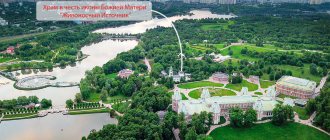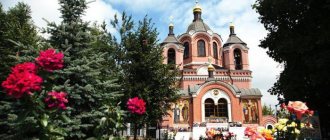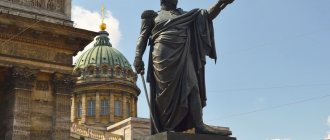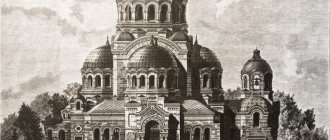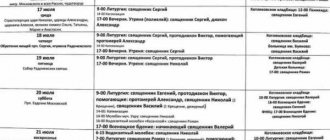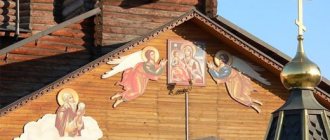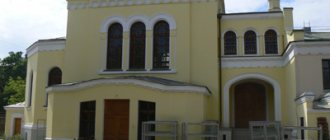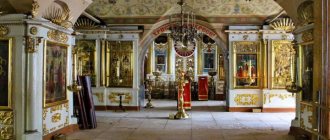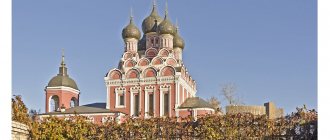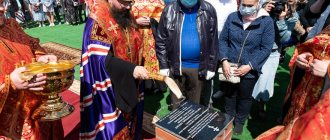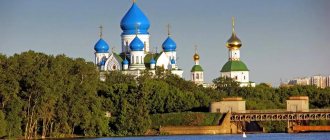| Church of the Icon of the Mother of God Life-Giving Spring in Tsaritsyno |
Moscow Church in honor of the Icon of the Mother of God “Life-Giving Source” in Tsaritsyn,
Moscow Diocese
- Thrones: icons of the Mother of God “Life-Giving Source”, martyr. Demetrius of Thessalonica, Kazan Icon of the Mother of God
- Address: Russia, Moscow, Dolskaya st., 2
- Website:
- On the map: Yandex.Map, Google map
The temple is located on the territory of the palace and park ensemble of the late 18th century.
Directions: to the metro station Tsaritsyno, Orekhovo. The first church on this site was built in the 1680s by the will of Prince Vasily Vasilyevich Golitsyn and his son Alexei as a parish church in honor of the icon of the Mother of God “Life-Giving Source”. At that time, the Black Dirt estate was superbly equipped, an extensive farm was established here and an impressive wooden church was erected. In the description books of the Golitsyn princes it is said that the church was: “ ...about five domes, covered with scales of greenery, painted with three colors, in front of the church there is a chopped wooden bell tower, painted with different paints
.»
In 1689, with the fall of Princess Sophia, her favorite, Prince Vasily Golitsyn, fell into disgrace, and with him his son and grandson of the Streshnevs, Alexei, whose estates were taken to the treasury “for their guilt.” In 1713, the “Black Dirt” estate was donated by Tsar Peter I to the Moldavian ruler, His Serene Highness Prince Dmitry Cantemir “for special services to the fatherland.” In 1722, by order of Cantemir and designed by architect P. N. Lavin, a stone church was built on the site of a wooden church. In 1759-1765, the church was rebuilt by his son and heir Matvey Dmitrievich Kantemir, who built the northern chapel dedicated (in memory of his father) to the Great Martyr Demetrius of Thessalonica. The temple served as the tomb of the family: on November 30, 1771, Prince Matvey Dmitrievich was buried here, and later his wife Princess Agrafena Yakovlevna.
In 1775, Empress Catherine II bought the estate from Kantemirov and renamed it the village of Tsaritsyno. At the same time, the queen instructed the architect V.I. Bazhenov to draw up and implement a project for her country residence on the purchased estate. When drawing up the project for the palace complex, Bazhenov retained the Cantemir Church as an element in the ensemble of estate buildings.
In 1883-1885, the church was again rebuilt with the money of A.I. Klementovich, the owner of one of the dachas located in Tsaritsyn, as well as with public funds collected for this purpose. At that time, the refectory was expanded, a chapel in honor of the Kazan Icon of the Mother of God was added, and the bell tower was moved and increased in height (from three to four tiers). According to the inventory of the village of Tsaritsyno and from the recollections of old parishioners of the church, it is known that in the pre-revolutionary period there were two wooden houses near the church in which priests lived.
| Chapel "Life-Giving Spring" of the Icon of the Mother of God in Tsaritsyno |
The church operated as a parish until 1939, when it was closed for non-payment of debts.
After the closure, the church building was converted into a transformer booth, in the 1970s - into a printing house, and from 1975 to 1990 it housed a carpentry workshop at the Soyuzrestavratsia V/O, with heavy woodworking machines, the work of which was severely damaged and the building itself (cracks appeared in the walls and domes) and the wall paintings of the temple. One of the wooden houses for the clergy, located very close to the church, was demolished by carpentry workers and a brick house was built on its foundation. In 1990, the temple was transferred to the use of the community of Orthodox believers, and Archpriest Georgy Breev was appointed rector. On October 6 of the same year, services resumed. The church was also given a brick house standing on the site of the former priest's house.
Activities of the parish
Christians can use the services of a large library located next to the temple. Not only believers and parishioners come here, but also schoolchildren, students and simply those who like to learn a lot of new things about Christianity. There are now about 18,000 storage units. These are books, cassettes, magazines, manuals, textbooks, newspapers and brochures.
The Sunday school holds enrollments for every school year. Preschoolers, teenagers and adults are welcome. What is studied in the courses is the basics of the catechism, the history of the Old and New Testaments, Christian architecture and the Church Slavonic language. Training is free.
Important! At the Sunday school, they created a support group for citizens who were in prisons, zones, and pre-trial detention centers.
In addition, the Tsaritsyn Church organizes pilgrimage trips to holy places and springs. Lawyers and psychologists provide their services here. You can come and get a completely free consultation and answers to your pressing questions.
Divine service at the Life-Giving Spring Church
Various clubs are organized at the temple:
- wood paintings;
- maths, physics;
- drawing;
- vocal lessons;
- English for adults;
- bead weaving.
Despite all the persecution that the church suffered and the bans, the faith of Orthodox Christians triumphed. The Lord helped return the temple to the parishioners.
Schedule of services
Divine services are performed every day:
- on weekdays Liturgy from 09.00 and service at 17.00;
- on Saturday, Sunday and holidays - Liturgy begins at 09.00 and 10.00, evening - at 17.00.
In addition to the main services, every Sunday the Akathist to the Most Holy Theotokos is read in the church.
Shrines and patronal feasts
Many believers come to the temple every day. Here are buried:
- reliquary with the relics of St. Tikhon of Moscow;
- pieces of the relics of Mitrofan of Voronezh and the saints of the Kiev Pechersk Lavra.
It is in this church that the holy icon of the Mother of God, called the “Life-Giving Spring,” is located.
Temple image on the apse of the Church of the Life-Giving Spring
May 3 is the feast of the icon of the Mother of God “Life-Giving Spring.” November 8 is the day of memory of Demetrius of Thessaloniki. On this day he died.
The Kazan Icon of the Mother of God is celebrated on July 21 - this is the day of Her appearance in Kazan.
The earliest of all surviving architectural monuments on the territory of the Tsaritsyn ensemble.
The first wooden church appeared on this site in the 17th century. By the beginning of the 18th century it was greatly deteriorating. In 1722, the owner of the local estate Black Mud - the Moldavian prince Dmitry Cantemir - built a new temple in its place with a stone lower part and a wooden top. The church is crowned with a single-domed dome. In 1759, Prince Matvey Kantemir Jr. asked the Moscow Metropolitan for permission to dismantle the old church and build a new one - completely made of stone. The new temple is being built of brick in the Elizabethan Baroque style. The base and decor are made of white stone. On the western side, a low two-tier bell tower adjoins the temple. The consecration takes place on June 23, 1765.
In 1775, Catherine II bought “Black Mud” and renamed it Tsaritsyno. Under the leadership of the court architect Vasily Bazhenov, construction of the imperial residence begins here. Bazhenov includes the temple in a new architectural ensemble.
During the War of 1812, the church was damaged. The caretaker of Tsaritsyno A. Egorov reported to the Kremlin expedition of buildings in 1813: “last September 1812, from the 12th, teams of soldiers found enemy troops in the village of Tsaritsyno at the church, the doors were broken and some things were robbed, and placed in it for safety from fire The hair files are all broken and scattered.”
At the end of the 1880s. Tsaritsino is turning into a prestigious holiday village. By that time, the temple and bell tower were rebuilt according to the design of the architectural and technical bureau “P. N. Lavin and Co. The refectory is expanding. The southern aisle was consecrated. The inside of the temple is decorated with paintings and stucco decorations. The floor is laid asphalt with a sprinkle of marble.
The bell tower becomes four-tiered - there are now six bells on it. The largest weighs 180 pounds. After the October Revolution of 1917, the temple is still in operation - despite the active anti-clerical activities of the Political and Sports Youth Union (the organization occupies the building of the Third Cavalry Corps nearby). Even in the 1920–1930s. Representatives of ancient noble families living in the village of Lenino (Tsaritsyno) - the Obolenskys and the Sheremetevs - still come to the church. Services and sacraments do not stop in the temple.
However, in 1934, the bells were thrown from the bell tower. And in 1938 the temple was closed. Some icons are taken away by parishioners and clergy. Some are given to museums. However, most of the church utensils and icons are destroyed.
Since the 1940s The temple building is used as a transformer substation. In the 1970s - like a printing house. In 1975, it housed the woodworking workshop of the scientific and restoration workshops of the Soyuzrestavratsiya association.
In the fall of 1990, the temple was handed over to the community of believers - services were resumed there. From the pre-revolutionary decoration in the temple, paintings from the late 19th - early 20th centuries have been preserved. and baroque stucco from the 18th - 19th centuries.
On May 6, 1998, the temple was again consecrated by Patriarch Alexy II.
Temple in Tsaritsyno, within Moscow
The building of 1722 was erected to replace the wooden church of the Streshnev boyars, who previously owned the estate. During the construction of the palace, Bazhenov preserved the temple in Tsaritsyno, then it went through several reconstructions and additions, the last one was carried out by the architect Lavin. The church was closed only in 1939 and was used to house an electrical transformer. In the 70s of the last century there was a printing house there, then a carpentry workshop. The church in Tsaritsino was returned to the Russian Orthodox Church in 1990; the absence of serious damage made it possible to soon consecrate the church and resume services.
A photograph from the northeast gives an idea of the architectural appearance of the temple in Tsaritsyno today. The tetrahedral shape of the altar apse is not quite common; usually the outlines are smooth. Otherwise, everything is traditional - a quadruple base, with an octagonal central volume on it. Next is a rectangular refectory and a bell tower, made at the same time as the entire temple.
The traditional government protection warning sign provides some information about the church's founder. It is worth saying that the scientific works of Dmitry Cantemir had a historical and philosophical orientation and concerned Moldova and the Ottoman Empire. He also wrote the first historical novel in the Moldavian language. There were significantly more political events and titles in Cantemir’s life.
Being the son of the ruler (sovereign) of Moldova, he himself was confirmed in office by the Turkish Sultan with delays and delays. Contrary to the condition set by the Sultan to prepare for war with Russia, he entered into an alliance with Peter the Great, participated in the Prut campaign, and then lived in Russia. Kantemir - the elder was an imperial adviser and comrade-in-arms, received the title of His Serene Highness, and was a senator with the rank of Privy Councilor.
A little about the construction of the shrine
As the name implies, the temple is consecrated in honor of the Life-Giving Spring. History says that in the 5th century, near Constantinople, there was a grove dedicated to the Virgin Mary. And there was a source that was considered miraculous. The Mother of God herself pointed out the location of this source to people.
Everyone who came to this source received healing from serious illnesses. In gratitude for the healing received, people first fenced the spring with a stone fence, and a little later they built a small church. It was sent to everyone who sincerely asked for help in healing.
The best article for you, go to: Temple of Faith, Hope and Love and their mother Sophia
This area did not get its name right away. Under Catherine II, Prince Golitsyn was the owner of the site where the church was built. In the years when there were Streltsy riots, it was taken away and it went to the treasury. It should be noted that the temple was originally built of wood, and it passed from one owner to another.
Of course, everyone rebuilt it a little and used it as a family tomb. And only when the site became the property of the Empress, the site was completely rebuilt. At that time, they changed its name to “Tsaritsyno”. Her summer residence was located on this territory.
Like many other churches, it was closed in 1939. After closing, a transformer booth was first placed in it, after which it housed a printing house and even a woodworking workshop. It is not surprising that the building could not withstand such tests and began to collapse a little. And only in the early 90s was the church in Tsaritsyn returned to Orthodox believers. In the same year, work began on its restoration.
Today the temple is open and fully functioning. In addition to holding services in the Tsaritsyno temple, there is a church library here, which contains a wide variety of rare books. It can be visited not only by those who study in Sunday school, but also by any interested parishioner.
The best article for you, go to: Church of the Assumption of the Blessed Virgin Mary in Veshnyaki
There is a Sunday school at the church. On its basis, a special group carries out its work, which is engaged in supporting individuals who, for one reason or another, are deprived of their freedom. The church is also known for its pilgrimage trips. She also provides free legal and psychological consultations.
Russian Orthodox ChurchFinancial and economic management
Object of cultural heritage of federal significance “Ensemble of the Tsaritsyno estate, 18th century. Church (Temple of the Icon of the Mother of God “Life-Giving Source”)”
Address: st. Dolskaya, 2, building 1
Rector: Archpriest Oleg Korytko
Contractor: STG-group LLC (2019-2018)
Technical supervision: NP "Unified Customer Service of the Moscow Patriarchate" (2018-2022)
Author's supervision: STG-group LLC (2019) Author's supervision: ArtResStroy LLC (2018)
Temple website: spring-life.ru
RESTORATION
As part of the Program for Providing Subsidies from the Moscow City Budget, the work will be financed from 2022.
In 2022, work began with the bell tower : the facades, white stone plinth, completions (dome and cross) were restored, the roof and roof structures were repaired, work was carried out to recreate window and door carpentry, install cut-off waterproofing and blind areas.
In 2022, the following work was carried out: restoration of the brickwork of the facades of the quadrangle and the refectory part of the temple , including elements of white stone decor and plinth, porches and basements, reconstruction of windows and doors, repair of roof structures and coverings, including protruding parts, restoration of the temple’s ends .
In 2020, the craftsmen moved on to the interiors of the temple: to the restoration of wall paintings and stucco decoration in the quadrangle, the altar and the domed part, and the repair of stone floors. The interiors of the bell tower were also restored.
In 2022, it was planned to carry out the following types of work: restoration and recreation of oil painting in the interiors of the temple (narthexes of the quadrangle, southern aisle), installation of “marble towels”, restoration of architectural and stucco decoration with subsequent gilding of surfaces in the interiors of the temple (narthexes and the main volume of the quadrangle) .
for 2022 : restoration and reconstruction of paintings in the interiors of the refectory and western vestibule, reconstruction of the lining of the “marble towels” of the western vestibule, restoration of architectural stucco decoration with subsequent gilding of surfaces in the interiors of the refectory.
AllTemple of the Icon of the Mother of God “Life-Giving Spring” in Tsaritsyn
AllTemple of the Icon of the Mother of God “Life-Giving Spring” in Tsaritsyn (published 02.02.2022)
Story
The temple is located on the territory of the Tsaritsyno Museum-Reserve.
The church in Tsaritsyn, located on the territory of the palace and park ensemble of the late 18th century, was built long before the construction of the palace as the parish church of the “Blessed Virgin Mary of the Life-Giving Spring.”
It is known that in 1633 the Black Mud estate was acquired by boyar A.S. Streshnev, and in 1680 it was inherited by his grandson Prince A.S. Golitsyn, under whom the estate was superbly equipped and an extensive farm was established.
The Streshnev boyars built a wooden church, about which in the inventory books of the Golitsyn princes it is said: “... about five chapters, covered with scales of greenery, painted with three colors, .. in front of the church there is a chopped wooden bell tower, painted with different paints.”
In 1689, with the fall of Princess Sophia, her favorite Prince Vasily Golitsyn fell into disgrace, and with him his son and grandson A.S. Streshnevs. Golitsyn, and their estates were taken to the treasury “for their guilt.”
In 1713, the estate “Black Mud” was donated by Peter I to the Moldavian ruler Dmitry Konstantinovich Cantemir “for special services to the fatherland” in the fight against the Turks, the same famous Cantemir, whose three hundredth anniversary was celebrated by UNESCO in 1973, an outstanding linguist, philosopher, an architect, archaeologist, musician and mathematician who knew several languages, incl. Turkish and Persian, and who managed the office of Peter I during the Persian campaign.
In 1722, Cantemir built a stone church in the Petrine Baroque style on the site of a wooden church. In 1759-1765 the church was rebuilt by his son and heir M.D. Kantemir. The temple served as the tomb of the family. In 1771, on November 30, Prince M. D. Cantemir was buried here, and later his wife Princess A. Ya. Cantemir.
In 1775, Catherine II bought the Black Dirt estate from the Kantemirovs and renamed it the village of Tsaritsyno. The Empress commissioned the architect V.I. Bazhenov to draw up and implement a project for her country residence on the purchased estate. When drawing up the design of the palace complex, Bazhenov retained the Cantemir Church as an element in the ensemble of estate buildings.
At the end of the 19th century. The church was again rebuilt with the money of A.I. Klementovich, the owner of one of the dachas located in Tsaritsyn, as well as with public funds collected for this purpose. The refectory was expanded, for which it actually had to be rebuilt, a chapel in the name of the Kazan Icon of the Mother of God was added, and the bell tower was moved and increased in height (up to four tiers).
The church operated as a parish until 1939, when it was closed for non-payment of debts. After closing, the church building was converted into a transformer booth in the 1970s. - for a printing house, and from 1975 to 1990. it housed the carpentry workshop SNRM-3 at the Union of Soyuzrestavratsiya, with heavy woodworking machines, the work of which damaged both the building itself (cracks appeared in the walls and domes) and the wall paintings of the temple.
In 1990, the Church of the Mother of God Life-Giving Spring was transferred to the use of the community of believers, Archpriest Georgy Breev was appointed rector, and services resumed on October 6.
According to the inventory of the village of Tsaritsyno and from the recollections of old parishioners of the temple, it is known that there were two wooden houses near the church in which the priests lived. One of them, located very close to the church, was demolished by carpentry workers and a brick house was built on its foundation, now transferred to the use of the Church.
External appearance of the temple in Tsaritsino
The bell tower, which also serves as the entrance to the temple in Tsaritsino, consists of four tiers of decreasing height. Above the entrance is a mosaic image of the Virgin and Child, and next to the doors is a previously seen sign. The second tier with ordinary glazing is the abode of bell ringers; the belfry occupies the two upper tiers.
The highest third tier is intended for the largest bells; the area of the openings there is the largest. The opening is outlined by a large arch, inside of which there are two narrow ones, converging in the middle into a single opening. On the fourth tier there is no external arch, the opening and bells are smaller. On the hipped roof there is a light drum with a relatively small dome.
The summer surroundings surrounding the temple in Tsaritsino are very picturesque and well-groomed. Evenly trimmed lawn grass is separated by curbs from neat walking paths. There are many trees around the building, especially a giant larch, clearly of considerable age, that stands out. People in the church fence move slowly and respectably, only restless children can run around and lie on the grass.
A winter view from almost the same point shows the greatly changed appearance of the temple in Tsaritsyno. The trunks and branches of the trees that have lost their leaves have become almost invisible; the larch that has lost its needles does not look like a summer larch. The few passers-by are dressed very differently, the Christmas slogan on the fence reminds of the already obvious time of year.
But in winter, nothing prevents you from examining the appearance and design features that characterize the temple in Tsaritsyno. The method chosen by the builders to highlight significant elements of the building is striking. The pilasters and window casings, as well as some other details of the structure, are painted white.
Like all Russian nature, the surroundings of the church have their charms in any season of the year, and every weather is good.
All the more indifferent is seasonality when applied to a spiritual refuge, if only true faith leads there, and not habit or pretense. Tags: MoscowRussiaestate-museumtempleTsaritsino
